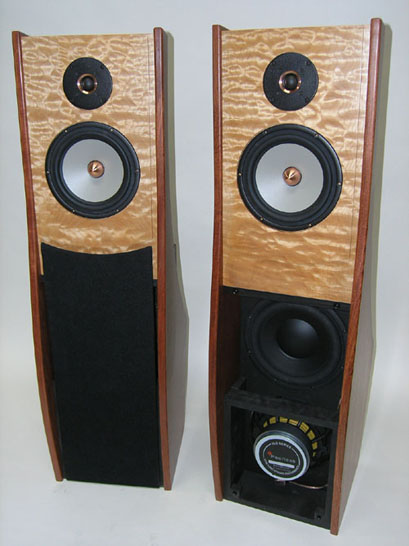Powered 3-Way Dipole Loudspeaker System Linkwitz Lab “Orion 3.2.1”
- 04 Dec 2010 11:42
- 919

Designer: Linkwitz Lab, 15 Prospect Lane, Corte Madera, CA 94925. E-mail: sl@linkwitzlab.com. Web: www.linkwitzlab.com. Constructor: Wood Artistry, L.L.C., 408 Moore Lane, Healdsburg, CA 95448. Voice: (707) 473-0593. Fax: (707) 473-0653. E-mail: sales@woodartistry.com. Web: www.woodartistry.com. Orion 3.2.1 loudspeaker system (latest revision), $9200 and up for two complete channels (custom-built, with electronic crossover/equalizer, all necessary cables, and ATI AT6012 twelve-channel power amplifier). Kit versions available in various stages of completion at lower prices. Tested samples owned by The Audio Critic.
Yes, another Orion revision, even though no one dislikes revisions more than Siegfried Linkwitz. (“There comes a time to shoot the designer” is one of his witticisms, originating from his Hewlett-Packard days.) The trouble is, the man is too honest. Equalized electrodynamic dipoles are still relatively virgin territory, and there are always new insights, generally small, which he could shrug off, but his conscience won’t let him. He remains the only loudspeaker designer known to me with (1) the highest technological qualifications and (2) an ear that really knows the sound of live, unamplified music. That being the case, we must live with his urge to fine-tune his products and his penchant to think out loud on his website before the fine-tuning is complete, creating major waves of anxiety among owners of his designs. Between the Orion+ of three years ago and the present Orion 3.2.1, there were three agonizing temporary versions. I know because I went through the agony. Such is the price of perfectionism. (For the moment, version 3.2.1 appears to be final, thank goodness.)
I must quickly add that, even though the Orion+ was a definite advancement and now the Orion 3.2.1 is a further important improvement, nothing compares to the breakthrough represented by the original suffixless Orion. Switching to that speaker from even the best conventional box speaker (“monkey coffin”) was night and day. The Orion+ merely provided more daylight and the Orion 3.2.1 still more.
The Changes
I have written a great deal about the Orion, so here I’ll discuss only what is new. The Orion 3.2.1 is physically no different from the Orion+; all the changes are in the electronics, but they are significant. The EQ in the crossover/equalizer has undergone serious readjustments in both the midrange and the treble. Linkwitz has long suspected that the acoustic output of the midrange driver wasn’t quite as flat as it could be, but his computer modeling of the complex interactions of the various EQ curves and notch filters didn’t quite jell until very recently. The result was (temporary) version 3.0, an undeniable improvement in the midrange.
Then came another eureka moment, after Linkwitz had read Acoustics and Hearing, a new book by Dr. Peter Damaske, a German scientist summarizing a whole lifetime of studies. Among other things, Damaske shows how “surround sound” can be obtained out of two channels (but Orion owners already know that!); what Linkwitz was looking for, and found, was scientific evidence of something else that he already knew by subjective experience—that a pair of anechoically flat loudspeakers must have their treble response attenuated when brought into a normal, reverberant listening room. (He is never satisfied knowing something intuitively without a scientific theory to back it up.) How much attenuation is needed, and starting at what frequency, required a bit of experimentation, hence those in-between versions that we could have been spared.
Mind you, all these changes are fairly subtle and very difficult to measure quasi-anechoically with my somewhat crude MLS technique. I’d just as soon not publish any curves and refer you to www.linkwitzlab.com instead. Of course, if the changes weren’t subtle, the unchanged previous versions wouldn’t have sounded as great as they did. But they definitely didn’t sound as good as version 3.2.1.
There are also some minor changes in the 3.2.1 that are unrelated to the audio upgrade. The switchable subsonic filter is now 30-Hz highpass instead of 50-Hz highpass to let more bass content through when switched in, while still remaining effective as a rumble filter. The trim pots are much larger and easier to turn with a screwdriver. The tweeter trim pot has a narrower plus/minus range than before because of the critical contour of the new high-frequency shelving. And, by the way, you can without too much difficulty make all the 3.2.1 circuit changes on the motherboard yourself, provided you aren’t quite as ham-fisted with a soldering iron as I am.
The Sound
So, what exactly is the sound of the 3.2.1? Even the original, suffixless Orion produced a uniquely three-dimensional soundstage, and the Orion+ with its additional rearward-firing tweeter added still more realism. Version 3.2.1 has now brought everything into perfect balance. The 3-D effect is considerably more precise, with left, right, middle, front, back, height, etc., more palpable than before. The trumpet is right there, the timpani are over here, the space between them is about this much, the clarinet is just left of center, the hall is not very big, and so on. Earlier versions of the Orion did not focus quite as sharply. Also (and this is important), the highs are more relaxed and natural, as well as richer and rounder. Just greater realism all around. It is quite a bit easier with version 3.2.1 to close your eyes and imagine a living audio scene in front of you.
All of this is, of course, quite subjective. The changes in the crossover/equalizer are easy to measure, the resulting acoustical changes not so easy, but the audible quality changes are entirely a matter of opinion. All opinions known to me so far, however, are in favor of the changes. The Orion 3.2.1 lives in the overlapping regions between scientific audio engineering and psychoacoustics. Among the domestic loudspeaker systems I am familiar with, it is the most highly refined and the easiest virtual transportation to the original live audio event.
* * *
One more thing. As far as the need for subwoofers is concerned, what I have written about the Orion+ remains unchanged. The Linkwitz “Thor” woofers can be added, or not, to the Orion 3.2.1 as before. As I indicated, in the majority of cases that will not be necessary.
